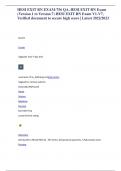Zusammenfassung
Inferential statistics PART II complete summary based on the studybook: Stats: Data and Models, 5th Edition by Richard D. De Veaux & Paul F. Velleman.
- Kurs
- Hochschule
- Book
Inferential statistics PART II complete summary (PAY ATTENTION, only for part II of the course). Based on the studybook: Stats: Data and Models, 5th Edition by Richard D. De Veaux & Paul F. Velleman. Summary for lecture 8, lecture 9, lecture 10, lecture 11, lecture 12, lecture 13 and lecture 14.
[ Mehr anzeigen ]







